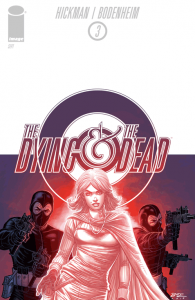Publishers: Image Comics
Writer: Jonathan Hickman
Artist: Ryan Bodenheim
Colourist: Michael Garland
Release date: OUT NOW!
Price: $3.50/ Digital: $2.99

In the Dying and the Dead #3 writer Jonathan Hickman finds a fun way to reintroduce Sumerian mythology. Of course, it wouldn’t be a Jonathan Hickman comic book if the reader did not leave it feeling a bit confused.
In The Dying and the Dead #3 the Sumerian gods, or aliens, depending on your point of view, are called Baduri, which is translated as a specific kind of water, the kind feeding the Trees of Life. They seek the Bah al’ Sharur, the only weapon capable of destroying them.
The Dying and the Dead #3 moves away from the series storyline to a 1944 flashback revealing the weapon’s origin, recounted by Japanese Emperor Hirohito to Adolph Hitler and Benito Mussolini. In Sumerian mythology Sharur, a mace or hammer, was the weapon of Ninurta, god of hunting and war, and translate as “smasher of thousands.” The Baduri have culled mankind several times and finally became embroiled in civil war. It’s then that the hammer is recast as a spear, no doubt a reference to the Spear of Destiny (the lance that supposedly pierced Jesus’ side).
Once the Baduri rebels are defeated the Bah al’ Sharur is disassembled into three pieces and scattered across the globe (just like Dragonballs!). Now the Axis powers have it, and would use it to kill the seemingly immortal Baduri who control mankind from the shadows. But Hirohito will have none of it, because killing the Baduri would expose the lie of immortality, and as a god to his people Hirohito must also be considered immortal. The Japanese emperor takes prejudiced action to prevent Hitler and Mussolini from carrying out their plan. But the explanation is weak, since the Japanese don’t know about the existence of the hidden Baduri.
There are several interesting themes running through The Dying and the Dead #3 including free will, mankind’s destiny, mortality and eugenics. Hitler notes that all the Baduri culling made mankind stronger and smarter. The Baduri “did all the things one would normally do if the goal was engineering a perfect species for war,” he says.
Ryan Bodenheim’s art is smooth and his coloring is layered and subtle. Well-drafted and attractive, it gives much attention to detail.
For fans of mythological historical mysteries, The Dying and the Dead #3 is satisfying fix, which hopefully becomes clearer as the series progresses.
Review: Joe Lovece
Reviews Editor: Steve Hooker

